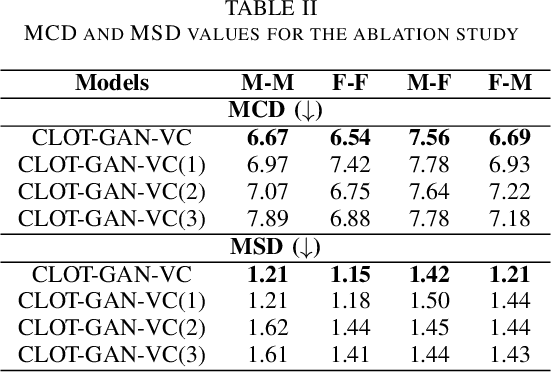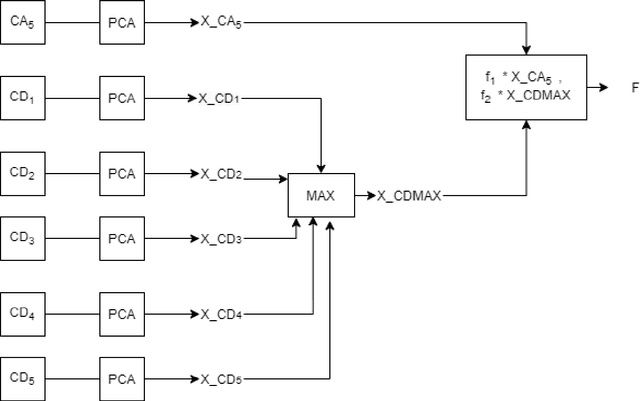Nanda Dulal Jana
Generative Adversarial Network based Voice Conversion: Techniques, Challenges, and Recent Advancements
Apr 27, 2025Abstract:Voice conversion (VC) stands as a crucial research area in speech synthesis, enabling the transformation of a speaker's vocal characteristics to resemble another while preserving the linguistic content. This technology has broad applications, including automated movie dubbing, speech-to-singing conversion, and assistive devices for pathological speech rehabilitation. With the increasing demand for high-quality and natural-sounding synthetic voices, researchers have developed a wide range of VC techniques. Among these, generative adversarial network (GAN)-based approaches have drawn considerable attention for their powerful feature-mapping capabilities and potential to produce highly realistic speech. Despite notable advancements, challenges such as ensuring training stability, maintaining linguistic consistency, and achieving perceptual naturalness continue to hinder progress in GAN-based VC systems. This systematic review presents a comprehensive analysis of the voice conversion landscape, highlighting key techniques, key challenges, and the transformative impact of GANs in the field. The survey categorizes existing methods, examines technical obstacles, and critically evaluates recent developments in GAN-based VC. By consolidating and synthesizing research findings scattered across the literature, this review provides a structured understanding of the strengths and limitations of different approaches. The significance of this survey lies in its ability to guide future research by identifying existing gaps, proposing potential directions, and offering insights for building more robust and efficient VC systems. Overall, this work serves as an essential resource for researchers, developers, and practitioners aiming to advance the state-of-the-art (SOTA) in voice conversion technology.
Collective Learning Mechanism based Optimal Transport Generative Adversarial Network for Non-parallel Voice Conversion
Apr 18, 2025



Abstract:After demonstrating significant success in image synthesis, Generative Adversarial Network (GAN) models have likewise made significant progress in the field of speech synthesis, leveraging their capacity to adapt the precise distribution of target data through adversarial learning processes. Notably, in the realm of State-Of-The-Art (SOTA) GAN-based Voice Conversion (VC) models, there exists a substantial disparity in naturalness between real and GAN-generated speech samples. Furthermore, while many GAN models currently operate on a single generator discriminator learning approach, optimizing target data distribution is more effectively achievable through a single generator multi-discriminator learning scheme. Hence, this study introduces a novel GAN model named Collective Learning Mechanism-based Optimal Transport GAN (CLOT-GAN) model, incorporating multiple discriminators, including the Deep Convolutional Neural Network (DCNN) model, Vision Transformer (ViT), and conformer. The objective of integrating various discriminators lies in their ability to comprehend the formant distribution of mel-spectrograms, facilitated by a collective learning mechanism. Simultaneously, the inclusion of Optimal Transport (OT) loss aims to precisely bridge the gap between the source and target data distribution, employing the principles of OT theory. The experimental validation on VCC 2018, VCTK, and CMU-Arctic datasets confirms that the CLOT-GAN-VC model outperforms existing VC models in objective and subjective assessments.
Differential Evolution Algorithm based Hyper-Parameters Selection of Convolutional Neural Network for Speech Command Recognition
Oct 13, 2023Abstract:Speech Command Recognition (SCR), which deals with identification of short uttered speech commands, is crucial for various applications, including IoT devices and assistive technology. Despite the promise shown by Convolutional Neural Networks (CNNs) in SCR tasks, their efficacy relies heavily on hyper-parameter selection, which is typically laborious and time-consuming when done manually. This paper introduces a hyper-parameter selection method for CNNs based on the Differential Evolution (DE) algorithm, aiming to enhance performance in SCR tasks. Training and testing with the Google Speech Command (GSC) dataset, the proposed approach showed effectiveness in classifying speech commands. Moreover, a comparative analysis with Genetic Algorithm based selections and other deep CNN (DCNN) models highlighted the efficiency of the proposed DE algorithm in hyper-parameter selection for CNNs in SCR tasks.
Detection of Epilepsy Seizure using Different Dimensionality Reduction Techniques and Machine Learning on Transform Domain
Feb 17, 2023



Abstract:An Electroencephalogram (EEG) is a non-invasive exam that records the electrical activity of the brain. This exam is used to help diagnose conditions such as different brain problems. EEG signals are taken for the purpose of epilepsy detection and with Discrete Wavelet Transform (DWT) and machine learning classifier, they perform epilepsy detection. In Epilepsy seizure detection, mainly machine learning classifiers and statistical features are used. The hidden information in the EEG signal is useful for detecting diseases affecting the brain. Sometimes it is very difficult to identify the minimum changes in the EEG in time and frequency domains purpose. The DWT can give a good decomposition of the signals in different frequency bands and feature extraction. We use the tri-dimensionality reduction algorithm.; Principal Component Analysis (PCA), Independent Component Analysis (ICA) and Linear Discriminant Analysis (LDA). Finally, features are selected by using a fusion rule and at the last step three different classifiers Support Vector Machine (SVM), Naive Bayes (NB) and K-Nearest-Neighbor (KNN) has been used for the classification. The proposed framework is tested on the Bonn dataset and the simulation results provide the maximum accuracy for the combination of LDA and NB for 10-fold cross validation technique. It shows the maximum average sensitivity, specificity, accuracy, Precision and Recall of 100%, 100%, 100%, 100% and 100%. The results prove the effectiveness of this model.
An Efficient Epileptic Seizure Detection Technique using Discrete Wavelet Transform and Machine Learning Classifiers
Sep 26, 2021



Abstract:This paper presents an epilepsy detection method based on discrete wavelet transform (DWT) and Machine learning classifiers. Here DWT has been used for feature extraction as it provides a better decomposition of the signals in different frequency bands. At first, DWT has been applied to the EEG signal to extract the detail and approximate coefficients or different sub-bands. After the extraction of the coefficients, principal component analysis (PCA) has been applied on different sub-bands and then a feature level fusion technique is used to extract the important features in low dimensional feature space. Three classifiers namely: Support Vector Machine (SVM) classifier, K-Nearest-Neighbor (KNN) classifier, and Naive Bayes (NB) Classifiers have been used in the proposed work for classifying the EEG signals. The proposed method is tested on Bonn databases and provides a maximum of 100% recognition accuracy for KNN, SVM, NB classifiers.
An Adaptive Learning based Generative Adversarial Network for One-To-One Voice Conversion
Apr 25, 2021



Abstract:Voice Conversion (VC) emerged as a significant domain of research in the field of speech synthesis in recent years due to its emerging application in voice-assisting technology, automated movie dubbing, and speech-to-singing conversion to name a few. VC basically deals with the conversion of vocal style of one speaker to another speaker while keeping the linguistic contents unchanged. VC task is performed through a three-stage pipeline consisting of speech analysis, speech feature mapping, and speech reconstruction. Nowadays the Generative Adversarial Network (GAN) models are widely in use for speech feature mapping from source to target speaker. In this paper, we propose an adaptive learning-based GAN model called ALGAN-VC for an efficient one-to-one VC of speakers. Our ALGAN-VC framework consists of some approaches to improve the speech quality and voice similarity between source and target speakers. The model incorporates a Dense Residual Network (DRN) like architecture to the generator network for efficient speech feature learning, for source to target speech feature conversion. We also integrate an adaptive learning mechanism to compute the loss function for the proposed model. Moreover, we use a boosted learning rate approach to enhance the learning capability of the proposed model. The model is trained by using both forward and inverse mapping simultaneously for a one-to-one VC. The proposed model is tested on Voice Conversion Challenge (VCC) 2016, 2018, and 2020 datasets as well as on our self-prepared speech dataset, which has been recorded in Indian regional languages and in English. A subjective and objective evaluation of the generated speech samples indicated that the proposed model elegantly performed the voice conversion task by achieving high speaker similarity and adequate speech quality.
Accuracy Improvement of Neural Network Training using Particle Swarm Optimization and its Stability Analysis for Classification
May 15, 2019



Abstract:Supervised classification is the most active and emerging research trends in today's scenario. In this view, Artificial Neural Network (ANN) techniques have been widely employed and growing interest to the researchers day by day. ANN training aims to find the proper setting of parameters such as weights ($\textbf{W}$) and biases ($b$) to properly classify the given data samples. The training process is formulated in an error minimization problem which consists of many local optima in the search landscape. In this paper, an enhanced Particle Swarm Optimization is proposed to minimize the error function for classifying real-life data sets. A stability analysis is performed to establish the efficiency of the proposed method for improving classification accuracy. The performance measurement such as confusion matrix, $F$-measure and convergence graph indicates the significant improvement in the classification accuracy.
 Add to Chrome
Add to Chrome Add to Firefox
Add to Firefox Add to Edge
Add to Edge